#callinectes sapidus
Photo

A blue crab (Callinectes sapidus) fishing in a unique transition between fresh and salt water in the Mexican cenotes.
Image © Martin Broen
258 notes
·
View notes
Text
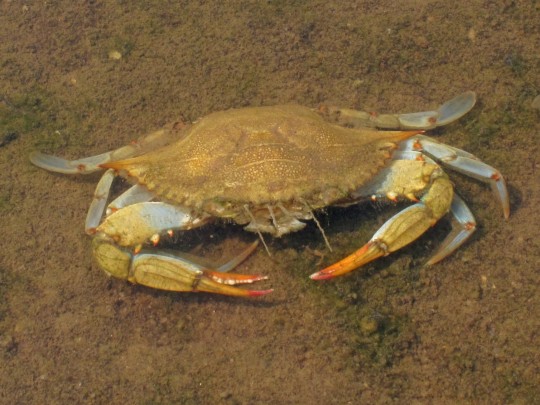
Atlantic Blue Crab
5 notes
·
View notes
Text
"Invasivi, voraci ma, nonostante il colore poco invitante, incredibilmente buoni. I granchi blu, la specie aliena che da tre anni si è fatta largo lungo il litorale laziale e che sta facendo perdere il sonno agli ambientalisti per quest’ennesima aggressione all’ecosistema, sono considerati da molti una pietanza succulenta. Nell’attesa dell’eventuale via libera alla loro commercializzazione, in questi mesi a fare affari sono così gli abusivi, che vendono i crostacei originari della sponda occidentale dell’oceano Atlantico al mercato nero."
E così, da specie invasiva difficile da eradicare, passeremo a specie invasiva impossibile da eradicare. Visto che, diventando ufficialmente commercializzabile, non solo verrà introdotta ancora di più per ottenere più prodotto, ma i commercianti si opporranno a qualsiasi progetto di eradicazione... perché mica vorrà far fuori un intero settore economico, signora mia!
2 notes
·
View notes
Text
Look at this crab claw I found. I thought it was a can of pepsi someone threw in the water like a jackass but nope!!
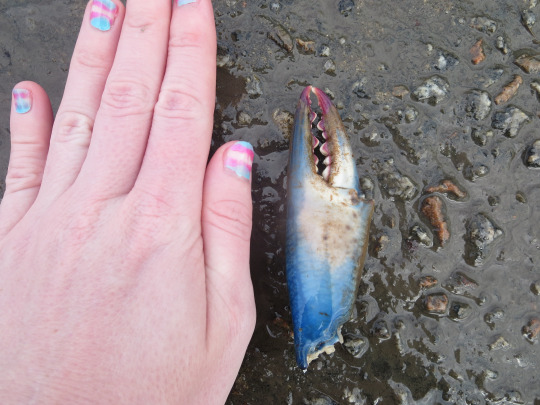
[ID: A photo of a large blue and white crab claw sitting on muddy pavement, with a white hand next to it for scale, with the fingernails painted in the trans pride flag colors.
The tips of the claws are red-purple, and most of the claw is a deep, shiny bright blue, with some white at the base of the pincers.
End ID.]
It's from an aptly named Atlantic blue crab. They're super pretty.
2 notes
·
View notes
Text
Callinectes sapidus, Rathbun, Granchio blu
Callinectes sapidus, Rathbun, Granchio blu
Callinectes sapidus, Rathbun, Granchio blu
Il granchio reale blu, granchio blu o granchio azzurro, Callinectes sapidus Rathbun, è un crostaceo decapode, nello specifico un granchio della famiglia dei Portunidi. È originaria della sponda occidentale dell’oceano Atlantico, dove vive lungo le coste dell’intero continente americano, dalla Nuova Scozia…

View On WordPress
0 notes
Text
l'étonnante vitesse de la nage d'un crabe [video]
Nouvel article publié sur https://www.2tout2rien.fr/letonnante-vitesse-de-la-nage-dun-crabe-video/
l'étonnante vitesse de la nage d'un crabe [video]
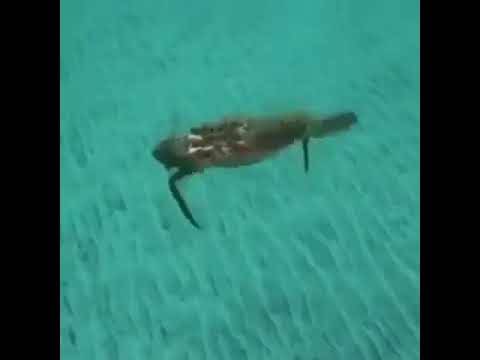
0 notes
Text

Fun fact: Heiwa has a crab as a pet. Now you may be thinking aw a hermit crab that's so cool. No. It's the regular kind of crab that you find in the ocean and/or dinner plate. Literally it's just. A regular-ass crab except it's twelve inches across and weighs nearly a pound and a half. And it may or may not be magic, nobody's sure. It follows him around like a dog and Tello hates it with the passion of a thousand thousand fiery suns because the sounds of its legs creeps them out but it's not like they can do anything about it without making Heiwa sad and getting Alpha after them again so they just suffer.
8 notes
·
View notes
Text

Callinectes sapidus
382 notes
·
View notes
Text
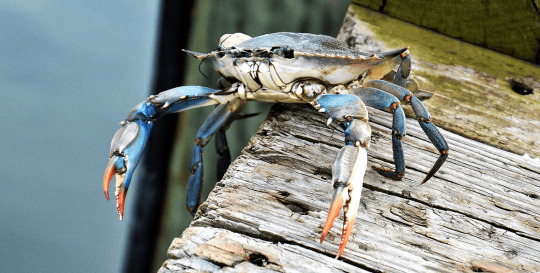


At Last, the Atlantic Blue Crab!
A common sight on dinner tables in Canada, America, and Mexico, the blue crab-- also known as the Atlantic blue crab or the Maryland Blue crab (Callinectes sapidus)-- is native to the the Gulf of Mexico and the Atlantic coast of North America. This species is a bottom dweller, and can occupy a range of habitats from freshwater tributaries to the open bays and gulfs of the ocean itself. At times it may be found at high tide, but most individuals remain submerged at depths up to 36 m (120 ft) deep.
As indicated by its name, the claws and front body of male blue crabs are bright blue. Females are carry a blue tinge, but are largely brown or olive, though the tips of their claws are bright red. Otherwise, the two sexes may be distinguished by the shape of their underside, or "apron"; males have an inverted 'T' shape, while females have a wider, rounder shape. Individuals of both sexes may grow up to 23 cm (9 in) in width, and weigh up to 136 g (0.3 lbs).
Spawning for C. sapidus can occur year-round, but for most populations it peaks in October or November. When females are ready, they travel up estuaries and rivers to where populations of males are more concentrated, and then release pheromones in their urine to attract mates. Male crabs then compete for access, and guard their chosen mates fiercely for up to a week. During this time, the female molts, at which point the male fertilizes her. Afterwards, she may retain her mate's sperm for up to a year, during which time she returns to saltier waters. A female can fertilize 2 million eggs at a time, and will carry them in a mass under her abdomen until they hatch, about a week after fertilization. She may do this as many as 4 times throughout a single mating season.
Once hatched, Atlantic blue crab larvae are released into the ocean. Each larvae spends 30-40 days going through seven larval stages known as zoea; these stages are similar to the instars of a larval insect. However, zoea have hard shells and must molt at each stage of development. After the initial zoea stages, juvenile C. sapidus enter the megalops stage, which lasts 6-20 days. During this time juveniles move from the ocean into the estuaries in which they spawned. Finally, they molt into their final form, which resembles an adult-- albeit much smaller. Both males and females continue to molt throughout the year until they reach their full size. In total, both sexes go through about 25 molts each throughout their lives, which spans about 3 years in the wild.
Blue crabs have a wide and varied diet, as they are omnivores. In their larval stages, Maryland blue crabs consume primarily plankton and detritus. Megalops and adults will feed on clams, mussels, and oysters, small fish, kelp, seaweed, carrion, smaller blue crabs, and animal waste. In turn, both juveniles and adults are food for eels, large fish some sharks, stingrays, and humans. In fact, predation upon larval and sub-adult blue crabs is so heavy that, of 8 million eggs released by the mother, only 1 or 2 typically survive to adulthood.
Conservation status: The Maryland blue crab has not been evaluated by the IUCN. However, in recent decades, fisheries have noticed a severe decline in abundance, likely due to over-harvesting and pollution.
If you send me proof that you’ve made a donation to UNRWA or another fund benefiting Palestinians– including esim donations and verified gofundmes– I’ll make art of any animal of your choosing.
Photos
Kim Cover
Lynn Strauss
Jo O'Keefe
#atlantic blue crab#Decapoda#Portunidae#swimming crabs#crabs#decapods#crustaceans#arthropods#marine fauna#marine arthropods#coasts#coastal arthropods#atlantic ocean
92 notes
·
View notes
Text
wikipedia tabs i have open on new year's day
Railgun
Gunboat
Loess
Kamchatka Peninsula
Ansible
Hainish Cycle
Key deer
Mount Rainier
Socialism with Chinese characteristics
Xi Jinping Thought
Historical nihilism
Three Represents
Scientific Outlook on Development
Blue crab
Callinectes sapidus
Crab cake
Diamondback terrapin
Turtle soup
Yellow-bellied slider
Red-eyed slider
Littoraria irrorata
Halite
Appanage
Princess
Penicillin
Raffinate
Kaali crater
Hittite mythology and religion
Augury
Dovecote
Fasenjān
Confucianism
Messier 87
Elliptical galaxy
Whirpool Galaxy
Spiral galaxy
Pinwheel Galaxy
Milky Way
Sagittarius A*
Messier 87
History of Christian universalism
Kardashev scale
Grand duke
PSR B1257+12
PSR B1257+12 B
55 Cancri e
Carbon planet
Chthonian planet
Tholin
Luna (goddess)
European rabbit
Heroin
Abscess
Acedia
Weltschmerz
Razor
Synthetic fiber
Marshal of Yugoslavia
65 notes
·
View notes
Text
Every summer, people flock to Maryland to eat blue crabs. Named for their brilliant sapphire-colored claws, blue crab is one of the most iconic species in the Chesapeake Bay. The scientific name for blue crabs, Callinectes sapidus, means “beautiful savory swimmer.”
In restaurants and at home, diners pile steamed and seasoned blue crabs in the middle of a table covered in paper. Then, using small mallets, knives, bare hands and fingers, they break open the hard shells and extract the juicy meat from inside.
It is a messy experience, especially with Old Bay seasoning and beer known locally as Natty Bohs, one that is quintessentially Maryland.
Though many people know firsthand how difficult it is to pick and clean crab meat, they often don’t realize how crab is processed when it is sold in stores already picked and cleaned. Most people also may not know that crab picking is a livelihood for many, mainly poor, women.
For generations, African American women from Maryland’s rural, maritime communities labored for crab houses on the Eastern Shore.
Today, fewer than 10 crab houses are left on the Shore. The workforce consists of mainly female migrant workers from Mexico who do the grueling job of picking crab for eight to nine hours a day, from late spring to early fall. They make on average of US$2.50 to $4.00 for every pound of crabmeat they pick.
That pay is roughly one-tenth to one-twelfth of the wholesale price of one pound – or about a half of a kilogram – of the seafood they pick, which is $35 to $44. In comparison, the Maryland minimum wage is $13.25 an hour, while the federal minimum wage is $7.25.
89 notes
·
View notes
Text

Crabriel from ULTRACRAB
Based on the Chesapeake Blue Crab, Callinectes sapidus.
2/18/23
44 notes
·
View notes
Text
VA Native Fish Hunting - 22

Today was a good lesson in things not needing to be exciting to be pleasant. I drove down a back road where I remembered hearing about water access - only to find the access was about 20 feet of mud and rocks. There wasn't even a good place to launch a kayak without getting scraped up. But I still spent a half hour plus there dipping around. My minnow traps came up empty but I managed to get a few neat finds.

In my very first dip I went a little too low and ended up unearthing some rocks - stuck to it was this fella. I wasn't sure what he was at first, but looking through the pictures later it was pretty clear this was a Skilletfish (Gobiesox strumosus), who despite the scientific name aren't related closely at all to true Gobies. Little 2-3 inch long fish, these inoffensive guys are hard to spot even when you are looking for them. But still - a cool fish and a first for me.
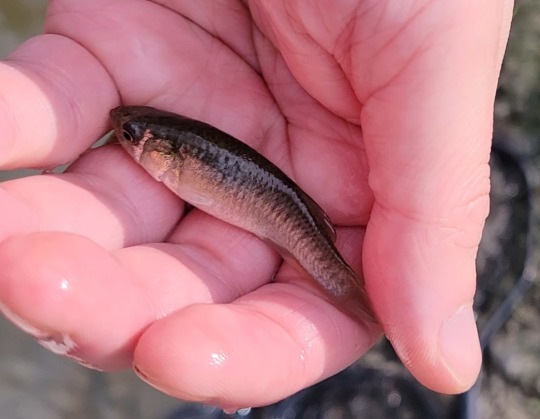
The most common fish here were Mummichogs (Fundulus heteroclitus), which is unsurprising given how populous they are in this river. Even then I only caught maybe 4 or 5 of them. The lack of plant life here to use as shelter really makes it hard for them to avoid the bigger predators we have the in the area, such as White Perches.
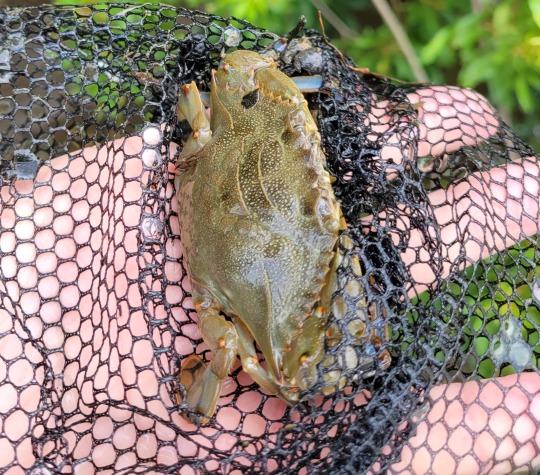
Blue Crabs (Callinectes sapidus) are definitely an iconic species in this area, but sadly they are getting harder to find. Even in the years where they are sparse, there's no shortage of crab traps in the area for people looking to make a buck. I really wish we'd put a moratorium on them for a year or two, I think it would help. Regardless. This little dude was maybe 3.5 inches across the carapace and was a good find.

The most populous invertebrate I caught, by FAR, were these Glass Shrimps (Palaemonetes spp. - probably P. pugio, maybe P. varians). It would be conservative to say I caught over 1 or 2 hundred while I was there with my dumpy little fishing nets. At close to 2 inches long, these guys were chunky little dudes too! I chose this picture to upload because you could cleary see the difference between the berried (right, female) and non-berried (left, presuming male) shrimps. Look at those long whiskers!

Also part of why I left early were the jellyfish, which have been bad this year around here. I avoided the ones near the surface easily enough, but the water was murky and I caught a handful of them near the bottom of the riverbed. Thankfully I was wearing boots, but even then I wasn't interested in potentially harming these guys, so I made like a tree and got out of there.
8 notes
·
View notes
Text
Mavi Yengeç Nasıl Yenir ve Nasıl Pişirilir?
Mavi yengeç, bilimsel adıyla Callinectes sapidus, Atlantik Okyanusu’nun doğu kıyısında ve Karayipler’de yaygın olarak bulunan bir yengeç türüdür. Özellikle Amerika Birleşik Devletleri’nin doğu kıyısı, Meksika Körfezi ve Karayipler bölgesinde bulunur. Bu tür, parlak mavi renkli kıskaçları ve bacakları ile tanınır, bu da onu diğer yengeç türlerinden ayıran belirgin bir özelliktir. Mavi yengeçlerin…

View On WordPress
0 notes
Text
Poisson lion, poisson lapin, crabe bleu... ces espèces invasives qui se développent avec le réchauffement de la Méditerranée et perturbent son équilibre
See on Scoop.it - Variétés entomologiques
Les canicules marines, conséquences du dérèglement climatique, pèsent sur les espèces natives mais sont propices à d'autres espèces venues d'ailleurs et plus résistantes.
Article rédigé par Guillaume Farriol
Radio France
Publié le 17/08/2024 07:35
Le crabe bleu, une espèce invasive comestible
"Le crabe bleu est une autre de ces espèces invasives problématique. Il est venu d'Amérique du Nord mais est très à l'aise dans les eaux chaudes. Il pullule sur les côtes et les lagunes méditerranéennes, déchire les filets des pécheurs et dévore les autres poissons. Alors pour s'en débarrasser, pourquoi ne pas le manger ? La Tunisie a par exemple monté une filière pour commercialiser ce crabe.
"Du crabe bleu, on est passé au crabe aux pinces d'or"
Nathalie Hilmi, économiste environnementale au Centre scientifique de Monaco
à franceinfo
"En fait, ils ont créé une industrie autour de ce nouveau crabe bleu, explique Nathalie Hilmi, économiste environnementale au Centre scientifique de Monaco, et ils arrivent maintenant à non seulement le pêcher et à le consommer sur place, mais également à le surgeler et à l'exporter, notamment en Asie."
Le crabe bleu représente aujourd'hui un quart des exportations tunisiennes de poissons et crustacés. L'économie se retrouve donc dépendante de cette espèce invasive, des quotas ont même été mis en place pour éviter qu'elle ne disparaisse à cause de la surpêche."
Callinectes sapidus
Bernadette Cassel's insight:
https://www.scoop.it/topic/entomonews?q=crabe%20bleu
0 notes
Text

#2
callinectes sapidus
callinectes - beautiful swimmer
sapidus - savoury
1 note
·
View note